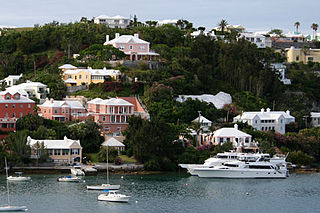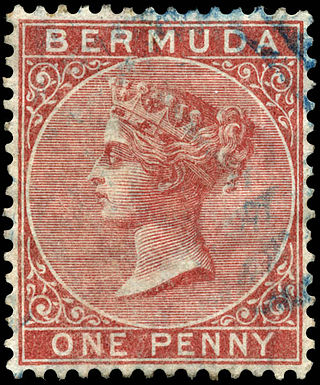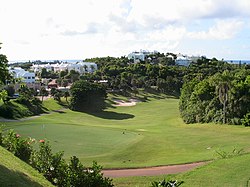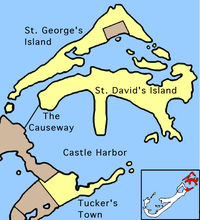
Bermuda is a British Overseas Territory in the North Atlantic Ocean. The Bermuda archipelago consists of 181 islands with a total land area of 54 km2 (21 sq mi). The closest land outside the territory is in the US state of North Carolina, approximately 1,035 km (643 mi) to the northwest.

Bermuda was first documented by a European in 1503 by Spanish explorer Juan de Bermúdez. In 1609, the English Virginia Company, which had established Jamestown in Virginia two years earlier, permanently settled Bermuda in the aftermath of a hurricane, when the crew and passengers of Sea Venture steered the ship onto the surrounding reef to prevent it from sinking, then landed ashore. Bermuda's first capital, St. George's, was established in 1612.

Bermuda is the oldest British Overseas Territory, and the oldest self-governing British Overseas Territory, and has a great degree of internal autonomy through authority and roles of governance delegated to it by the national Government. Its parliament held its first session in 1620, making it the third-oldest continuous parliament in the world. As part of the British realm, King Charles III is head of state and is represented in Bermuda by a Governor, whom he appoints on the advice of the British Government. The Governor has special responsibilities in four areas: external affairs, defence, internal security, and policing.

Bermuda is an overseas territory of the United Kingdom in the North Atlantic Ocean. Located off the east coast of the United States, it is situated around 1,770 km (1,100 mi) northeast of Miami, Florida, and 1,350 km (840 mi) south of Halifax, Nova Scotia, west of Portugal, northwest of Brazil, 1,759 km (1,093 mi) north of Havana, Cuba and north-northeast of San Juan, Puerto Rico. The nearest landmass is Cape Hatteras, North Carolina, about 1,030 km (640 mi) west-northwest, followed by Cape Sable Island, Nova Scotia, Canada 1,236 km northward. Although commonly referred to in the singular, the territory consists of approximately 138 islands, with a total area of 57 km2 (22 sq mi).

St. George's, located on the island and within the parish of the same names, settled in 1612, is the first permanent English settlement on the islands of Bermuda. It is often described as the third permanent British settlement in the Americas, after Jamestown, Virginia (1607), and Cupids, Newfoundland (1610), and the oldest continuously-inhabited British town in the New World, since the other two settlements were seasonal for a number of years.

Thomas Tudor Tucker was a Bermuda-born American physician and politician representing Charleston, South Carolina. He was elected from South Carolina in both the Continental Congress and the U.S. House. He later was appointed as Treasurer of the United States and served from 1801 to his death in 1828, establishing a record as the longest-serving Treasurer.
Captain William Sayle was a prominent British landholder who was Governor of Bermuda in 1643 and again in 1658. As an Independent in religion and politics, and an adherent of Oliver Cromwell, he was dissatisfied with life in Bermuda, and so founded the company of the Eleutheran Adventurers who became the first settlers of the Bahamas between 1646 and 1648. He later became the first governor of colonial South Carolina from 1670 to 1671.
The following is a list of places of interest in Bermuda.

The Governor of Bermuda is the representative of the British monarch in the British overseas territory of Bermuda.
The Somers Isles Company was formed in 1615 to operate the English colony of the Somers Isles, also known as Bermuda, as a commercial venture. It held a royal charter for Bermuda until 1684, when it was dissolved, and the Crown assumed responsibility for the administration of Bermuda as a royal colony.

The architecture of Bermuda has developed over the past four centuries. The archipelago's isolation, environment, climate, and scarce resources have been key driving points, though inspiration from Europe, the Caribbean and the Americas is evident. Distinctive elements appeared with initial settlement in the early 17th century, and by the second half of that century features that remain common today began to appear.
The Talbot Brothers were a musical group based in Bermuda that were among the most popular calypso performers of the 1950s. The band was composed of brothers Archie, Austin, Bryan, a.k.a. "Dick", Ross, a.k.a. "Blackie" and Roy Talbot (bass), and their cousin Cromwell "Mandy" Mandres (accordion).

The following is an alphabetical list of topics related to the British Overseas Territory of the Bermuda Islands.

Bermuda, a group of islands in the North Atlantic Ocean, was previously uninhabited when the British established a settlement in 1612.

George James Bruere was the British Governor of Bermuda from 1764 until his death. Of all Bermuda's governors since 1612, his term of office was the longest. He had a difficult time during the American Revolutionary War and is thought to have died of stress caused by the interplay of Bermudians and Continental rebels.
Edgar Fitzgerald Gordon, born in Trinidad and Tobago, was a physician, parliamentarian, civil-rights activist and labour leader in Bermuda, and is regarded as the "father of trade unionism" there: "he championed the cause of Bermudian workers and fought for equal rights for black Bermudians, thereby laying the groundwork for much of the political and social change that came about after his death". He was president of the Bermuda Industrial Union (BIU) 1945–55. Gordon has been described as "perhaps the only black charismatic leader to have emerged in the island's modern political history", and as "Bermuda's most dedicated Pan-Africanist".

HMS Castle Harbour was a civilian harbour vessel of 730 tons that was taken-up from trade (TUFT) during the Second World War by the Royal Naval Dockyard in Bermuda for use by the Royal Naval Examination Service and later armed and commissioned as a warship, providing harbour defence from submarines.
Colonel Robert Tucker was a member of the House of Burgesses who represented Norfolk County, Virginia, a mariner, and a slave owner. His father, mother and uncle, from the Caribbean, had an extensive mercantile trade and a number of ships that sailed throughout Chesapeake Bay and the Caribbean. In 1737, Robert Tucker inherited the mercantile empire and slaves that were crew members on ships. He was active in politics from the time that Norfolk, Virginia was established as a town. He became the first alderman and was a mayor three times. His role as alderman, a lifetime role, gave him a lot of power to determine how business would be conducted. Tucker also ran a mill and bakehouse.

Furness Bermuda Line new service to Bermuda in the 1920s created the need of additional modern accommodations for the tourists coming to the island after the first World War. This lead for Furness Withy, parent company of the line, to begin buying existing hotels and purchasing land for this new demand. This led to the formation of the Bermuda Development Company which would Furness' new business development. Eventually the company would manage four main properties: The St George, The Mid Ocean Club, Bermudiana, and the Castle Harbor Hotel. The hotels would continue to see increased business and benefit from legislation passed that would prevent ships from being used as hotels in 1938. Furness Withy would eventually sell all its ownership in the hotels by 1958.




















